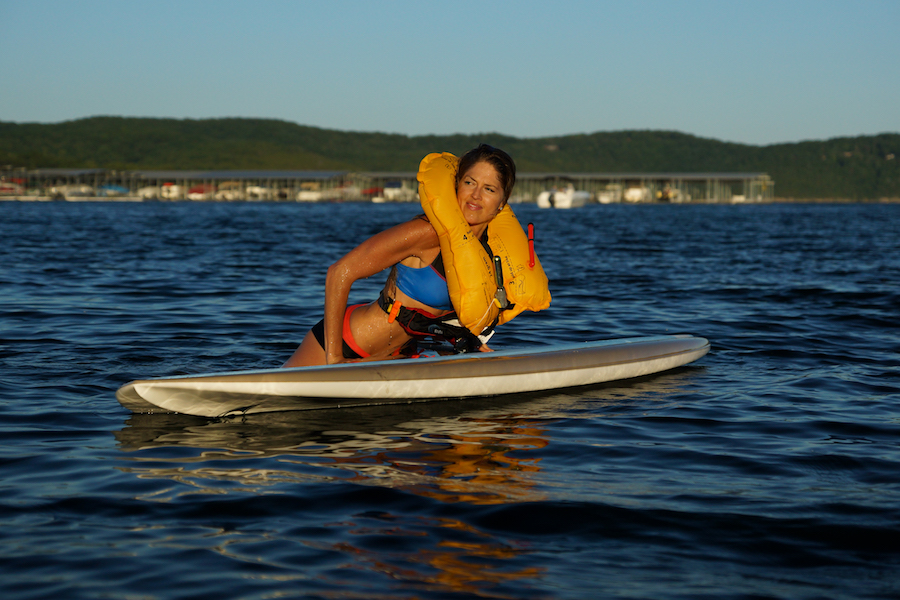With the development of SUP there are more and more places where it has become mandatory to wear a PFD. While for kayakers and canoeists it is part of the culture to wear a PFD, in SUP it is not the standard and considered somewhat uncool and uncomfortable to wear them. Given the regulations, and the fact that in many conditions and for most people, it is safer to wear flotation, companies have recently developed inflatable PFD belts. We asked Corran Addison, expert kayaker and SUP paddler, his view on the emerging question of what flotation to use, and when, while paddling SUP.
Paddleboarding is afflicted with an onslaught of regulation from government functionaries who are unaware of what is, or is not, safe in this sport.
More and more, the wearing of lifejackets is being imposed upon the sport worldwide, and so conform we must.
It doesn’t take a genius to see that the largest floating device in close proximity is the giant block of foam you’re standing on. Leash yourself to it, and you have the world’s safest, most buoyant device imaginable. Simply leashing yourself to your board is hands down the safest way to enjoy your paddling experience. It can’t get blown away from you, it has by far the most ability to float you, and getting back on board is easier as there are no belts, buckles and dangling objects to tangle.
This is not, however, the opinion of our all knowing governments, and so like it or not, we are faced with the reality of having to wear life jackets (or in some places, simply have a life jacket lashed to the board, which makes even less sense).
A life jacket is not required if you are surfing, but they are required once you leave the surf zone. While I am happy that I’m not forced to wear a jacket while surfing, these contrasting regulations show just how arbitrary and random government imposed regulations are.
This is NOT to say that in some environments, being leashed to your board AND wearing a life vest is not the best idea of all, but in most cases for most people, it’s a little like asking every-day drivers to wear a full face crash helmet inside their car on their daily commute. Simply put, it’s overkill.
Faced with the choices of a bad idea versus a worse idea, you have essentially two options to go for. A standard coast guard (or CE) approved lifejacket, or an inflatable one. Each have their place, and in the end, what it really comes down to is YOUR experience and your ability to make a safe judgment call given the environment into which you are about to enter.
Another place to consider a standard lifejacket is whitewater paddleboarders, where continuous dumping into raging rapids is an ongoing part of the day. Without a doubt, having a life jacket that is worn, and high in floatation, is the best way to go. The same could be argued for downwind paddling in rough seas.
That said, if you’re basically young and healthy, an experienced waterman, and you’re going into an environment that is essentially mundane and safe, and the only reason you’re even wearing a jacket at all is to avoid getting a ticket, then the inflatable jacket is the way to go.
I still advise leashing yourself to the board, as this remains the quickest and safest way to self rescue, but the jacket, neatly hidden into a small unobtrusive belt, will get you off the hook if you get pulled over by the water police. The belt also serves as a neat place to put keys and phone in as small dry bag (most SUPs do not have dry hatches).
These single use (a new canister has to be bought with each deployment) inflatable jackets are generally more expensive than a mundane lifejacket, so for some this might be a deciding factor. However, if you actually need a real life jacket, I wouldn’t recommend getting one on the cheap – if you’re going into an environment where your life depends on a functioning jacket, spend the money on the best you can find. It’s still cheap insurance.
You need to rely on common sense, experience, and the conditions of the day. If you are in any doubt, the defacto go-to should always be to leash yourself to your board, and wear a standard foam jacket. You simply cannot go wrong with this. Everything else is a step back that requires your good judgment to decide what’s right for you.
By: Corran Addison, Founder/owner Soul Waterman
Photo: Jodelle Fitzwater by Mandy McMurdo/MTI


